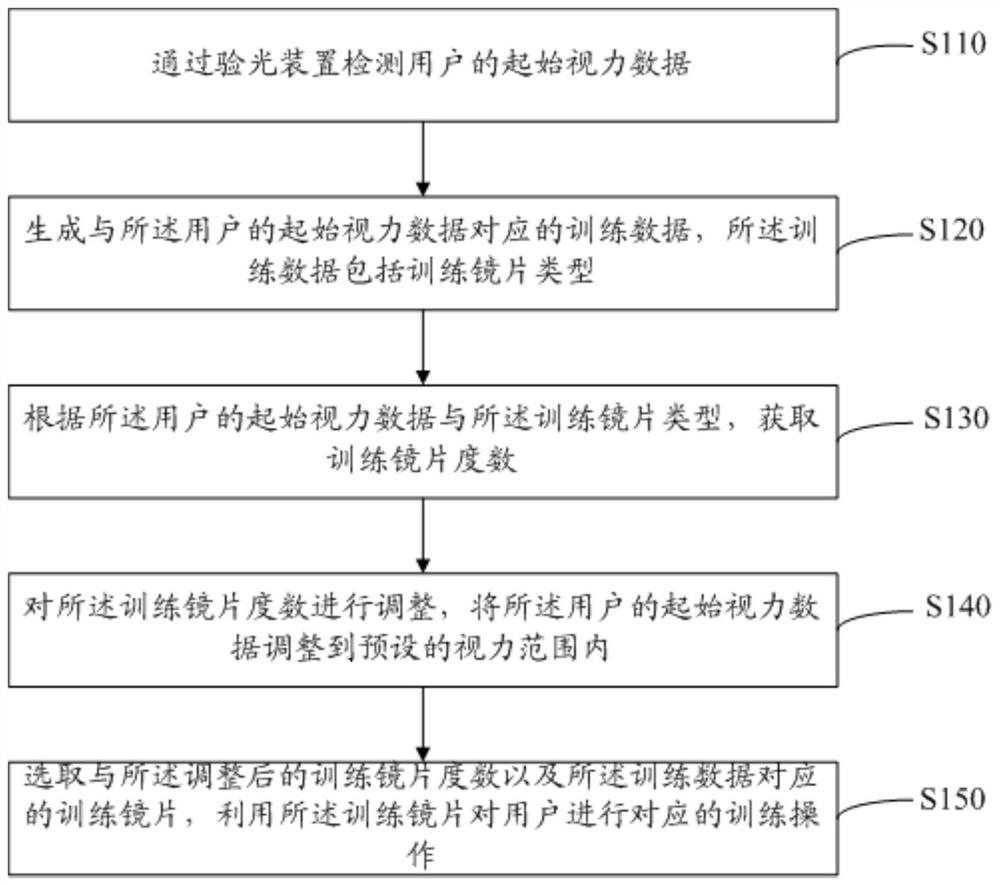A vision correction assisting method and system
A vision correction and auxiliary system technology, applied in physical therapy, eye exercisers, etc., can solve problems such as prone to rebound, unstable vision, and risks, so as to improve vision, avoid surgical risks and sequelae, and reduce diopter Effect
- Summary
- Abstract
- Description
- Claims
- Application Information
AI Technical Summary
Problems solved by technology
Method used
Image
Examples
Embodiment 1
[0027] figure 1 The implementation flow of a vision correction assistance method provided by an embodiment of the present invention is shown, and the details are as follows:
[0028] In step S110, the initial visual acuity data of the user is detected by the optometry device.
[0029] In the embodiment of the present invention, the optometry device may be a computer optometry instrument.
[0030] In a preferred embodiment of the present invention, the basic information of the user can also be obtained, which can be entered by the user, and the basic information of the user can include the age of the user, whether training has been performed, the number of training times, the last training time, Vision data changes and other information.
[0031] In the embodiment of the present invention, the user's vision data includes the user's left eye vision data and right eye vision data, specifically including myopia data, astigmatism data, or normal vision data.
[0032] In the embo...
Embodiment 2
[0049] figure 2 It shows the implementation process of the vision correction assistance method provided by the second embodiment of the present invention, which is similar to the first embodiment, except that the training lens corresponding to the adjusted training lens power and the training data is selected, Using the training glasses to perform corresponding training operations on the user, and then include:
[0050] In step S210, after the training is over, the current vision data of the user is detected by the optometry device.
[0051] In the embodiment of the present invention, after the user performs training through the obtained training lenses and training data, the user's vision is detected again through the optometry device to obtain the user's current vision data. As an implementation scenario, in order to ensure vision The accuracy of the data can be tested at intervals of preset time, for example, at intervals of 5 minutes.
[0052] In step S220, when the use...
Embodiment 3
[0058] image 3 It shows the implementation process of the training operation method provided by the third embodiment of the present invention, which is similar to the first embodiment, except that the training lens corresponding to the adjusted training lens power and the training data is selected, Using the training glasses to perform corresponding training operations on users includes:
[0059] In step S310, a training lens corresponding to the adjusted training lens power and the training data is selected, and the training lens is placed at a preset position.
[0060] In the embodiment of the present invention, the preset position is based on the height of the user's standing posture or the height of the sitting posture.
[0061] In the embodiment of the present invention, the step of selecting the corresponding lens according to the degree of the training lens and the type of the training lens includes:
[0062] When the user's initial vision data is myopia data, select...
PUM
 Login to View More
Login to View More Abstract
Description
Claims
Application Information
 Login to View More
Login to View More - R&D
- Intellectual Property
- Life Sciences
- Materials
- Tech Scout
- Unparalleled Data Quality
- Higher Quality Content
- 60% Fewer Hallucinations
Browse by: Latest US Patents, China's latest patents, Technical Efficacy Thesaurus, Application Domain, Technology Topic, Popular Technical Reports.
© 2025 PatSnap. All rights reserved.Legal|Privacy policy|Modern Slavery Act Transparency Statement|Sitemap|About US| Contact US: help@patsnap.com



